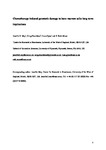Chemotherapy-induced genotoxic damage to bone marrow cells: long-term implications.
| dc.contributor.author | May, JE | en |
| dc.contributor.author | Donaldson, C | en |
| dc.contributor.author | Gynn, L | en |
| dc.contributor.author | Morse, HR | en |
| dc.date.accessioned | 2018-09-27T14:52:40Z | |
| dc.date.issued | 2018-09-17 | en |
| dc.identifier.uri | http://hdl.handle.net/10026.1/12426 | |
| dc.description.abstract |
Mesenchymal stem/stromal cells (MSCs) within the bone marrow (BM) are vitally important in forming the micro-environment supporting haematopoiesis after myeloablative chemotherapy. MSCs are known to be damaged phenotypically and functionally by chemotherapy; however, to the best our knowledge, the persistence of genotoxic effects of chemotherapy on the BM micro-environment has not been studied. We therefore aimed to evaluate genotoxic effects of chemotherapy on the BM both in vitro and in vivo, using the comet and micronucleus assays, focussing on the persistence of DNA lesions that may contribute to complications in the patient. The MSC cell line (HS-5) and primary cord blood mononuclear cells (CBMNCs: a source of undamaged DNA) were exposed to the chemotherapeutic agent cyclophosphamide (CY) within a physiologically relevant in vitro model. CY treatment resulted in significant increases in CBMNC DNA damage at all time points tested (3-48 h exposure). Similarly, HS-5 cells exposed to CY exhibited significant increases in DNA damage as measured by the comet assay, with increased numbers of abnormal cells visible in the micronucleus assay. In addition, even 48 h after removal of 48-h CY treatment, DNA damage remains significantly increased in treated cells relative to controls. In patients treated with chemotherapy for haematological malignancy, highly significant increases in damaged DNA were seen in BM cells isolated from one individual 1 year after completion of therapy for acute leukaemia compared with pretreatment (P < 0.001). Similarly, two individuals treated 7 and 17 years previously with chemotherapy exhibited significant increases of damaged DNA in MSC compared with untreated age- and sex-matched controls (P < 0.05). Unlike haematopoietic cells, MSCs are not replaced following a stem cell transplant. Therefore, long-term damage to MSC may impact on engraftment of either allogeneic or autologous transplants. In addition, persistence of DNA lesions may lead to genetic instability, correlating with the significant number of chemotherapy-treated individuals who have therapy-related malignancies. | en |
| dc.format.extent | 241 - 251 | en |
| dc.language.iso | en | en |
| dc.title | Chemotherapy-induced genotoxic damage to bone marrow cells: long-term implications. | en |
| dc.type | Journal Article | |
| plymouth.author-url | https://www.ncbi.nlm.nih.gov/pubmed/30239865 | en |
| plymouth.issue | 3 | en |
| plymouth.volume | 33 | en |
| plymouth.journal | Mutagenesis | en |
| dc.identifier.doi | 10.1093/mutage/gey014 | en |
| plymouth.organisational-group | /Plymouth | |
| plymouth.organisational-group | /Plymouth/Research Groups | |
| plymouth.organisational-group | /Plymouth/Research Groups/Institute of Translational and Stratified Medicine (ITSMED) | |
| plymouth.organisational-group | /Plymouth/Research Groups/Institute of Translational and Stratified Medicine (ITSMED)/CBR | |
| dcterms.dateAccepted | 2018-07-11 | en |
| dc.rights.embargodate | 2019-07-26 | en |
| dc.identifier.eissn | 1464-3804 | en |
| dc.rights.embargoperiod | Not known | en |
| rioxxterms.versionofrecord | 10.1093/mutage/gey014 | en |
| rioxxterms.licenseref.uri | http://www.rioxx.net/licenses/all-rights-reserved | en |
| rioxxterms.licenseref.startdate | 2018-09-17 | en |
| rioxxterms.type | Journal Article/Review | en |


